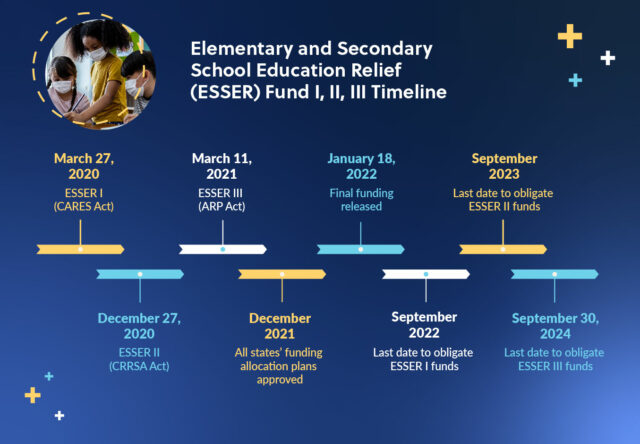 It has been two years since the start of the global pandemic and one year since President Biden signed the American Rescue Plan (ARP) Elementary and Secondary School Emergency Relief (ESSER) Act in an effort to mitigate the effects of COVID-19 on the education system. While the world slowly attempts to re-establish normalcy, educators have realized that they must upgrade and incorporate more technology. This is not only the new normal but also the key to recovering past learning losses and advancing to future success.
It has been two years since the start of the global pandemic and one year since President Biden signed the American Rescue Plan (ARP) Elementary and Secondary School Emergency Relief (ESSER) Act in an effort to mitigate the effects of COVID-19 on the education system. While the world slowly attempts to re-establish normalcy, educators have realized that they must upgrade and incorporate more technology. This is not only the new normal but also the key to recovering past learning losses and advancing to future success.
What is ARP ESSER?
In response to the pandemic, Congress passed several education funding bills to reopen K-12 schools safely and address learning loss. The third bill, the ARP ESSER, was signed into law on March 11, 2021. On March 17, 2021, Secretary of Education Miguel Cardona announced on behalf of the Department of Education that the ARP ESSER bill awarded $122 billion towards uses including educational technology.[1] “These funds from the American Rescue Plan… will allow schools to invest in mitigation strategies to get students back in the classroom… and address the many impacts this pandemic has had on students—especially those disproportionately impacted by the pandemic,” Cardona said.[2]
Within the stipulations of the ARP ESSER, 20% of the local education agencies’ (LEA) funding must be used for learning loss prevention in addition to 5% that must be reserved by state education agencies (SEA). The funding was allocated to the states and the LEAs had 30 days from the time of receiving the funds to create a spending plan. [3] All of the state plans[4] were submitted and approved by the Department of Education by the end of December 2021. With that approval, the remaining third of the funding ($41 million) was released.[5] SEAs and LEAs have until September 30, 2024 to obligate the ARP ESSER funding before unused funding must be returned to the Department of Education for reallocation.[6]

The Benefits to EDU and Continuing Needs
One of the biggest challenges teachers faced during the initial transition to remote education was learning loss because of the lack of connectivity, devices, and engagement of students. Part of the ARP ESSER Act allows funding usage for software, Wi-Fi hotspots, cybersecurity, devices, device management systems, and additional tech support.[2] With the assistance of ARP funds, 96% of K-12 public schools reopened as of January 2022 for full-time, in-person instruction[5]in comparison to 46% in January 2021.[7]
Beyond improving the in-person school situation, the additional funding allowed teachers to address the technological issues and see progress between semesters. According to Lanschool’s Distance Learning in Review, when schools went fully remote in spring 2020, teachers recorded an 86% worsening of student engagement. By fall 2020 with remote and hybrid learning, teachers reported a 69% improvement from the spring semester which Lanschool attributes to newly incorporated technologies, curriculum adjustments, and students’ adjustments to the “new norm.”[8]
Over 80% of teachers believe distance and hybrid learning will be a part of education for the foreseeable future with many educators stating that these new technologies and digital capabilities have streamlined their processes and improved efficiencies. The overwhelming majority of educators regularly utilize three or more digital tools and over 30% could see themselves incorporating additional tools.[9]In the future, the school systems surveyed plan to invest their remaining tech funding in areas such as:
- Audio enhancements
- Robotics
- Student coding apps
- Interactive whiteboards
- Core courseware
- Supplemental courseware, &
- Career and tech ed software[10]
The National Conference of State Legislatures created a tracker[11] that denotes the funding spent by each State and future plans for the remaining funds.
The Impact on Tech Companies
Due to ESSER fund usage, the U.S. K-12 educational technology spending spiked by $7.5 billion from 2019 to a total of $35.8 billion in 2020.[12] In 2021, EdTech spending rose to $36.7 billion.[10] This initial jump can be attributed to ESSER I with the CARES Act and represents a precursor to an even bigger influx with the ARP ESSER III funding. Although 2021 EdTech spending did not grow as much as initially expected, Learning Counsel CEO LeiLani Cauthen says that at least 60% of school districts have not spent their full allotment and plan to make additional tech purchases.[10]
With the priority of closing the “digital divide” with solutions for rural connectivity, devices for low-income students, and resources to ensure learning equity, tech companies have a large role to play in achieving the goal. Many tech companies have already marketed their resources to schools detailing how their technology aligns with the ARP ESSER stipulations and meets their learning needs. As schools finalize their plans for the allotment of funds, tech companies have a final opportunity to present their solutions and products and make a difference in the education system.
This collaboration between tech companies and schools to utilize the funding aligns with the Department of Education and President Biden’s mission to “build back better.”[13] Through provisions in the ARP ESSER Act, improvements have been made in education for students impacted by COVID-19. Not only is the schools and tech companies’ partnership assisting in recovering from learning loss through offering technological resources, it also paves the path for a better future.
Carahsoft is a leading education IT solutions distributor and provider prioritizing device management and cybersecurity solutions for higher education and K-12 schools. Visit our Education Technology Solutions Portfolio for more information on how Carahsoft can support your mission critical education needs.
[1] “U.S. Department of Education Fact Sheet: American Rescue Plan Act of 2021 – Elementary and Secondary School Emergency Relief Fund (ARP ESSER),” United States Department of Education, https://oese.ed.gov/files/2021/03/FINAL_ARP-ESSER-FACT-SHEET.pdf
[2] “Department of Education Announces American Rescue Plan Funds for All 50 States, Puerto Rico, and the District of Columbia to Help Schools Reopen,” United States Department of Education, https://www.ed.gov/news/press-releases/department-education-announces-american-rescue-plan-funds-all-50-states-puerto-rico-and-district-columbia-help-schools-reopen
[3] “Indiana Department of Education: ESSER III Frequently Asked Questions,” Indiana Department of Education, https://www.in.gov/doe/files/ESSER-III-FAQ-8.16.21.pdf?_sm_au_=iVVSPn0Q6NV6kQtFkN1JRKsp6MH81
[4] “Office of Elementary & Secondary Education: State Plans,” United States Office of Elementary & Secondary Education, https://oese.ed.gov/offices/american-rescue-plan/american-rescue-plan-elementary-and-secondary-school-emergency-relief/stateplans/
[5] “U.S. Department of Education Announces Distribution of All American Rescue Plan ESSER Funds and Approval of All 52 State Education Agency Plans,” United States Department of Education, https://www.ed.gov/news/press-releases/us-department-education-announces-distribution-all-american-rescue-plan-esser-funds-and-approval-all-52-state-education-agency-plans
[6] “U.S. Department of Education: Frequently Asked Questions – Elementary and Secondary School Emergency Relief Programs and Governor’s Emergency Education Relief Programs,” United States Department of Education, https://oese.ed.gov/files/2021/05/ESSER.GEER_.FAQs_5.26.21_745AM_FINALb0cd6833f6f46e03ba2d97d30aff953260028045f9ef3b18ea602db4b32b1d99.pdf
[7] “FACT SHEET: In One Year of the Biden-Harris Administration, the U.S. Department of Education Has Helped Schools Safely Reopen and Meet Students’ Needs,” United States Department of Education, https://www.ed.gov/news/press-releases/fact-sheet-one-year-biden-harris-administration-us-department-education-has-helped-schools-safely-reopen-and-meet-students%E2%80%99-needs
[8] “Distance Learning in Review Report,” Lanschool, https://lanschool.com/lp/2021-distance-learning-in-review/#report
[9] “Insights from Our 2021 Distance Learning in Review Report,” Lanschool, https://lanschool.com/blog/education-insights/insights-from-our-2021-distance-learning-in-review/
[10] “Just How Big is the EdTech Market? Watch This Briefing and Find Out!” The Learning Counsel, https://thelearningcounsel.com/articles/for-vendors/just-how-big-edtech-market-watch-briefing-and-find-out/
[11] “Elementary and Secondary School Emergency Relief Fund Tracker,” National Conference of State Legislatures, https://www.ncsl.org/ncsl-in-dc/standing-committees/education/cares-act-elementary-and-secondary-school-emergency-relief-fund-tracker.aspx
[12] “Tap Into Pandemic Relief Funds,” Gale: A Cengage Company, https://www.gale.com/schools/american-rescue-plan
[13] “U.S. Department of Education Approves Virginia’s Plan for Use of American Rescue Plan Funds to Support K-12 Schools and Students, Distributes Remaining More Than $704 Million to State,” United States Department of Education, https://www.ed.gov/news/press-releases/s-department-education-approves-virginias-plan-use-american-rescue-plan-funds-support-k-12-schools-and-students-distributes-remaining-more-704-million-state








